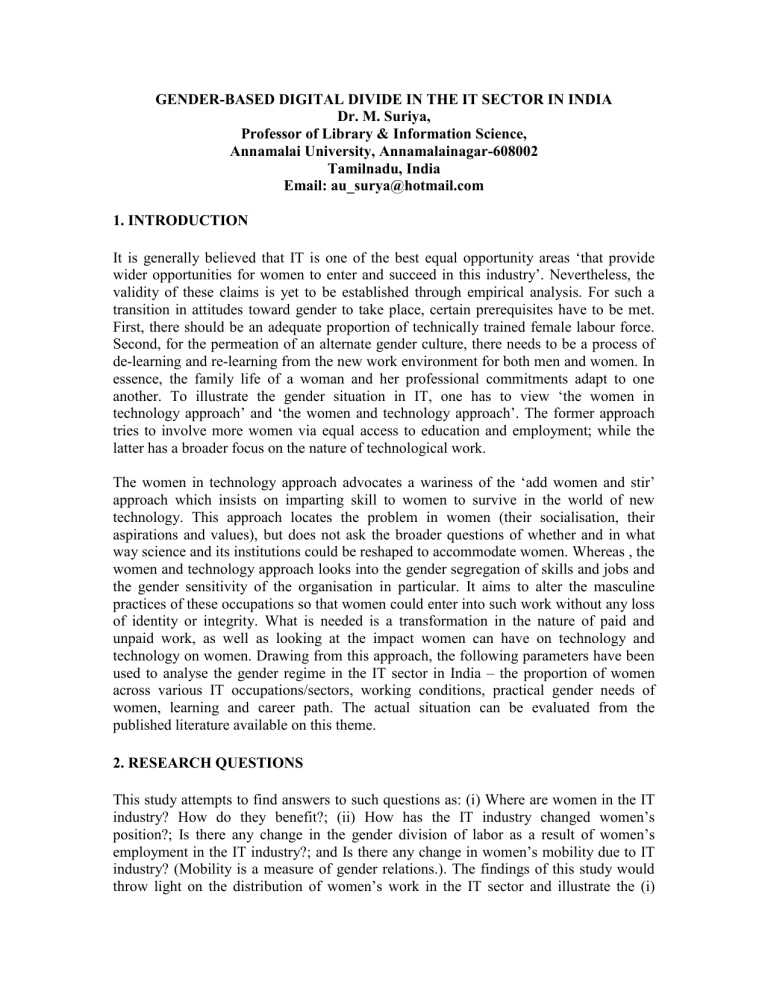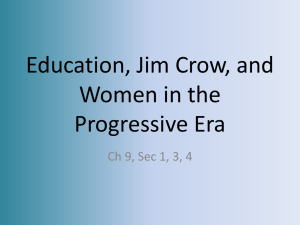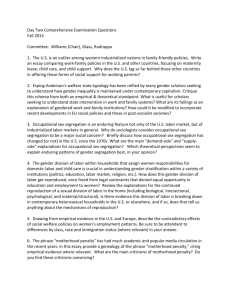Full text - University of South Australia
advertisement

GENDER-BASED DIGITAL DIVIDE IN THE IT SECTOR IN INDIA Dr. M. Suriya, Professor of Library & Information Science, Annamalai University, Annamalainagar-608002 Tamilnadu, India Email: au_surya@hotmail.com 1. INTRODUCTION It is generally believed that IT is one of the best equal opportunity areas ‘that provide wider opportunities for women to enter and succeed in this industry’. Nevertheless, the validity of these claims is yet to be established through empirical analysis. For such a transition in attitudes toward gender to take place, certain prerequisites have to be met. First, there should be an adequate proportion of technically trained female labour force. Second, for the permeation of an alternate gender culture, there needs to be a process of de-learning and re-learning from the new work environment for both men and women. In essence, the family life of a woman and her professional commitments adapt to one another. To illustrate the gender situation in IT, one has to view ‘the women in technology approach’ and ‘the women and technology approach’. The former approach tries to involve more women via equal access to education and employment; while the latter has a broader focus on the nature of technological work. The women in technology approach advocates a wariness of the ‘add women and stir’ approach which insists on imparting skill to women to survive in the world of new technology. This approach locates the problem in women (their socialisation, their aspirations and values), but does not ask the broader questions of whether and in what way science and its institutions could be reshaped to accommodate women. Whereas , the women and technology approach looks into the gender segregation of skills and jobs and the gender sensitivity of the organisation in particular. It aims to alter the masculine practices of these occupations so that women could enter into such work without any loss of identity or integrity. What is needed is a transformation in the nature of paid and unpaid work, as well as looking at the impact women can have on technology and technology on women. Drawing from this approach, the following parameters have been used to analyse the gender regime in the IT sector in India – the proportion of women across various IT occupations/sectors, working conditions, practical gender needs of women, learning and career path. The actual situation can be evaluated from the published literature available on this theme. 2. RESEARCH QUESTIONS This study attempts to find answers to such questions as: (i) Where are women in the IT industry? How do they benefit?; (ii) How has the IT industry changed women’s position?; Is there any change in the gender division of labor as a result of women’s employment in the IT industry?; and Is there any change in women’s mobility due to IT industry? (Mobility is a measure of gender relations.). The findings of this study would throw light on the distribution of women’s work in the IT sector and illustrate the (i) position of women in various service sectors; (ii) opportunities for women in the new economy; (iii) and the impact of changing organizational structures on women’s work. The gender situation is measured by adopting various common indicators like (i) the proportion of women in the various subsets of the IT industry; (ii) segregation of women across the high, medium and low end jobs; (iii) types of jobs undertaken; (iv) working condition of the organization; and the (v) facilities to learning and career progression. 3. STATUS OF WOMEN IN THE IT SECTOR IN INDIA It is reported that the proportion of women into the various IT based industries in India is in the order of 19% in the software industry; 40% in the telecom industry; 80% in the airlines; 45% in the ITES; and 50% in the BPOs. The high rate of women employees (45 percent on an average) in the ITES sector is a welcome change from the low 12.5 percent women being employed in the IT industry. According to a Dataquest-IDC survey in October 2002, the highest number of women was employed by NIIT at 29 percent while Rolta India employed the lowest number of women at four percent. Top software companies like Infosys employs 17 percent women, TCS employs 20 percent and Wipro employs 19 percent women. The massive incorporation of women into paid work has marginally increased their bargaining power and undermined the legitimacy of men’s domination as providers of the family. While women in positions of authority in the IT industry have improved their social position. The issue to be addressed is which categories of women are benefited through this sector? To which class of women does this help? What also came out quite well in the case studies is that there were different kinds of women. There are women who are top software programmers who can go to silicon valley and there are women who have to rely on Internet kiosks to start self employment. 4.JOB OPPORTUNITIES FOR INDIAN WOMEN IN THE IT SECTOR The IT sector in India has created employment opportunities in areas such as telecommunications, banking, shopping, education, health and business. In addition, the internet has also generated new jobs in areas like the design, maintenance and management of sites on the World Wide Web. There are real possibilities that women may be able to access opportunities they never had before. According to a prediction by National Association of Software and Services Companies (NASSCOM), by 2008 there will be one-and-a-half million jobs in the IT Enabled services. If 50% to 70% of these jobs were to go to women, the impact will be tremendous. There is going to be such a shortage of skills that women will have to be included. 5. GENDER SEGREGATION IN THE IT SECTOR When one examines the employment situation of women in industrial societies from a national and international viewpoint, one encounters forms of inequality between the genders, which have remained fixed despite wide-reaching changes. The phenomenon of gender segregation in the workplace remains valid regardless of profession or differing social and cultural factors on which the different systems of work are based. The computer occupations are expanding at a faster rate both within and in a wide range of other industries. The newness and the expanding nature of the computer industry has given an impression that it would be relatively immune to gender typed pattern of occupation and would maintain gender equity in its occupational distribution. However, an examination of the exisiting studies reveals that gender segregation is very much predominant in this industry, and it has absorbed the patriarchal power structure of the traditional industries. For instance, an ILO survey conducted among the IT professionals in the software industires in India has revealed the prevalence of gender inequality in its various forms. It has also show-cased how women are relegated to the less prestigious and low-paid jobs. Table:1: Gender-Wise Distribution of Professionals in Different Firm Types (Percent) High End Male Female 39.6 21.3 Middle Export Domestic End End low-end 9.4 17.0 35.4 27.7 8.3 12.8 IT Enabled Total 7.3 21.3 100 100 The high end firms undertake software products, R&D, turnkey solutions and strategic technical alliances. The professionals employed in this area are engineering graduates, mostly Ph.Ds and post-graduates with technical multi-skilling. The middle end firms undertake development of software packages, offshore services, and alliances for market access. This category of job demands engineering graduates who are geographically mobile and possess managerial multiskilling. The export end firms undertake onsite services, maintenance and implementation, alliances with labour contractors,etc. The domestic end jobs require only certificate holders with pure technical, coding and maintenance skills. The IT enabled and domestic end firms undertake low skilled and routinised jobs. The employees in this category of firms have to work in backoffice. The nature of job includes data entry and continuous partnership with clients. The above table illustrates that women’s representation outnumber their male counterparts in low-skilled and low-paid jobs. 6. DISTRIBUTION OF WOMEN’S WORK IN THE SUBSETS OF THE IT SECTOR IN INDIA What is the position of women in different sectors? The women in Mahendra British Telecom were engaged in some very different and creative kind of work. One woman had entirely done the Y2k for the company. For sometime, she even worked from home when there was a crisis at home. These were highly qualified women. There the ratio of women to men staff is about 40:60 while in the airlines sort of work it is about 80:20. This type of work has a much wider range of jobs that women do than those available in the electronics industry. Table:2 Segregation of women among the various subsets of IT S.No 1. IT Sector Software inudstry F/M Ratio 19:81 2. Telecom Industry* 40:60 3. Airlines 80:20 4. ITES (Medical 45:55 Type of Work & skill requirements Software development not just design, customization and adaptation of software Technical and creative work. Required highly qualified engineers Customer service. Required Communication, language & software skills Demands in linguistics and functional 5. Transcription) BPO** 49:51 /domain skill Indian BPO is predominantly voice-based (outbound calls) Mahendra British Telecom Wipro-Spectramind (TE: 5000; W/M ratio: 49:51%). Infowavz International (TE: 1000; W/M ratio: 40:60). TracMail India (T:1800; W/M ratio:35). ICICI OneSource (T:1800; W/M ratio:60:40). Dash E-Services (W/M ratio: 60:40) GE (W/M ratio: 60:40) 7. GENDER SEGREGATION ACROSS ITAND NONITOCCUPATIONS A comparative analysis of gender segregation in IT and non-IT industries in India (Mumbai based survery) has revealed that the IT industries are less segregated by gender than are the other industries. Not only the proportion of women in the IT industries are higher, but their position in the organizational hierarchy are also better than the other non-IT sectors. To some extent, the IT industries are more accommodative to women’s career development than the other non-IT sectors. Table3: Distribution of Women Employees by Various Sector (%) Job Categories Software Sector Finance & Banking Sector Media Sector Female workers 3.8 3.0 0.6 Female secretaries 11.4 6.0 4.3 Female officers 16.9 3.0 6.7 Total female employees No. of establishments No. of employees 32.1 12.0 12.0 76 56 24 12278 8631 7200 N.B. Based on the survey conducted in Mumbai 8.GENDER SEGREGATION IN THE ORGANIZATIONAL HIERARCHY OF THE IT SECTOR TABLE:4: Position of Men and Women in the Various Organisational Hierarchy Position Male Female Total (i) Call Services 40.00 60.00 100 (ii) Software Engineers 54.69 45.31 100 (iii Consultants 75.00 25.00 100 (iv) Project Managers 94.44 5.56 100 (v) Total 67.13 32.87 100 The above table have confirmed that women are overrepresented in some types of lower level jobs (call service and programmers) and underrepresented in in higer level jobs (consultants and project managers). The continud underrepresentation of women is pointed out by Jobahead survey conducted by the Dataquest. This may be due to the fact that women have a lower share of resources such as education, information, mobility, good health, nutritious food, leisure and rest as compared to men. As a result, they cannot fully develop their capabilities and remain lower than men in the job market. It is further stated that due to gender socialization factors, women are mostly associated with the secondary labour market. While analyzing the reasons for gender stereotypes, it is explained that since computer science has the masculine connotations of technical and scientific work, it is found inhospitable to women. Therefore, gender stereotypes in computer work is not new, but it is a newly applied version of longer-standing images. The other reasons attributed to gender segregation are (i) women’s own attitude to profession; (ii) employer’s discrimination; (iii) interactions of labour market; (iv) and gender relations in society. Some studies have argued that human capital and the structural location of women in the society are the two important factors driving gender inequality through segregation. It is said that the gender segregation takes its root from the hiring practices of the employers. 9. POSITION OF WOMEN IN THE VARIOUS SEGMENT OF THE SOFTWARE ACTIVITIES An analysis of the gender situation in the stratified nature of the software development activities (high value added & low valued added activities), shows that a largest segment of women are clustered in the low-end jobs; while a smallest segment of women are found at the higher end reflects to a larger extent the gender divide in the IT industry. Though women are better represented in the IT sector, they have not assumed significant role and status. Most of them have been concentrated in the lower status jobs such as coding and programming and only a minor percentage are noted in the development part of IT Table:5: Distribution of Women in the Various Segment of the Software Activities Sno Segment of Activities Companies 1 Development & marketing of software MNCs(Texas Instruments,Motorala) Large firms & MNCs package 2 3 Customization of software & development of software solutions (design projects Software services (coding, programming& testing either through body-shopping or off shore with extensive on-site work Small & medium sized software firms Contribution of Women Low Medium High 10. POSITON OF WOMEN IN THE ORGANISATIONAL HIERARCHY With the growth in the IT industry, there is a corresponding growth in job requirements in the areas of systems management, communications and network, systems development, technical support, operations and user support. Viewing the diversification and content of jobs, it is expected that the opportunities for women at different levels of hierarchies are expanding, but the existing studies have shown that this new and growing industry has been gendered. Evidences of low representation of women in most rewarding areas of computing work have signalled that gender inequalities are becoming even harder to ignore as an issue in this sector. The Dataquest survey reveals that though women make up about 20% of the IT workforce in India, only a few women reach the position of CEOs. As the seniority rises, the number of women shrinks. In the career pyramid, women are clustered in the bottom hierarchy. Nevertheless, the oxymoron is that while women tend to rise faster up the corporate ladder, few reach the highest levels. Even the few women who have struggled to reach the status of managers, have not been placed in the vital areas of work dealing with hardware and software oriented jobs, but are found in administration. Similarly, the women system workers are tied up with business oriented analysis, which is typically considered as less technical and therefore less challenging. This may be because of lack of technical orientation among the women. Women are seen as a passive users rather than designers of technology. Most women use ICT as a tool of production for tasks such as data entry, word processing and programming and as a tool of communication. This might be the reason for women’s under representation in higher, decision-making positions. For example, in customer call centres, women predominate in the lower positions and perform tasks such as data capture and verification, servicing of routine and account queries, order taking, referals, and after sales support. However, tasks that call for management authority, such as problem resolutions, were overwhelmingly performed by men. 11. REASONS FOR LOW PARTICIPATION OF WOMEN IN THE IT SECTOR The low enrollment of women in the science and technology impedes their ability to occupy higher positions in the IT organisations. According to 2001 census, female literacy is 54.16 % as against male literacy of 75.85 % in India. The enrollment of girls in educational institutions decreases as educational level goes higher. In particular, the percentage of girls enrolled to total enrollment is 43.6 % in primary, 40.1 % in middle, 37.1% in secondary level and 34.8 % in higher education according to statistics of 1997. The enrollment of girls in Engineering/Technology/Architecture at Graduation level (in 1998) is 57968 as against 285137 boys. This imbalance is largely due to socio-economic reasons. Empirical surveys conducted in the In addition, a series of social and cultural norms constrain women's access to ICT, especially in common use facilities, such as cyber-cafes, tele-centres and phone shops. In many culturally conservative societies, women are often not allowed to go out without supervision to public venues where men are present or seek help from male users or staff. This is yet another reason for the low rate of participation of women professionals. 12. CHALLENGES FOR CARRIER DEVELOPMENT OF WOMEN IN THE IT SECTOR There is not only restrictions at the entry point , but there are many barriers blocking women from moving up in the ladder of the organizational hierarchy. Studies have reported that women were not able to rise to the expected level of performance of the IT employers. With the advancement in the levels of experience, the ratio of women drops steadily and at the senior levels, women constitute less than 6% of the workforce. 13. FACTORS RESTRICTING WOMEN’S CAREER CHOICES: MARRIAGE & FAMILY COMMITMENTS The factors deterring women’s carrier choices have been analysed and presented by Dataquest surveys. Marriage is found out as a point at which the shrinkage of women from the career pipeline has started. The first sharp drop in the number of women professionals is at 3+ years of experience. It is because childcare and housework remain women’s responsibilities, irrespective of her income, educational level or employment. This places a great burden on women and restricts women’s choices in terms of better job opportunities. Though women employed in the IT industry are relatively free from domestic drudgery, this is a class-specific phenomenon restricted to a few in high level jobs whose domestic responsibilities have been transferred to women of a lower economic class. The opportunities offered by IT have only benefited a privileged few. The above table shows that only a few women rule in the workplace well into marriage. Married women outnumber men in low-experience categories, but in 10+ years’—the stage at which serious seniority should come in—a large number of women either opt out of their careers, or accept less demanding roles 14. FACTORS RESTRICTING WOMEN’S CHOICES: RELOCATION PREFERENCE The demands of high responsibility may also play a role in keeping women from accepting such jobs. "Women have traditionally shied away from sales responsibilities," says Gita Dang, head of technology practice at Korn & Ferry, "because it involves a great deal of travel. The bulk of the important selling in the Indian software industry, for instance, happens overseas. "It is these business development people who blossom into the CXO roles. Women are left behind as team leaders only." The data about relocation preferences of both sexes shows that women are far less willing to relocate. The willingness to relocate is a major factor that drives the growth of IT professionals. It is one of the areas where men outscore women. The other reasons that deter women from climbing up the carrier ladder includes the mounting pressure at work place, work timings, time flexibility and travel. 15. FACTORS RESTRICTING WOMEN’S CARRIER CHOICES: UNCONVENTIONAL WORKING HOURS The BPO industry which is a subset of the IT industry has its own unique conditions that pose impediments to achieve a good work-life balance for women. Offering a reason as to why women professionals tend not to rise above a certain level, Prakash Toppo, V-P, HR at Global Vantedge says, "Night shifts put an additional pressure on all employees in the ITeS sector. For women, it becomes even more challenging and hence the burnout is much higher. Marriage more or less forces women to quit night shift operations. For instance, the trend of more women employees in call centers is more visible in the North and the Western part of the country. In the South, although there has been considerable increase in the number of women employees in callcenters, yet it is quite low. This is attributed to the unconventional working hours that call centers have. 16. OBSTACLES FOR CARRIER DEVELOPMENT IN THE IT SECTOR: GENDER DISCRIMINATION IN THE WORKPLACE What about gender discrimination in the workplace? A Survey among the HR managers reported that gender discrimination is not considered as an issue because the type of work done by software professionals, whether men or women is the same and they have equal opportunities of rising up the ladder provided they stay on in the job. In software, as the surveys in the project reveal, women enjoy preferences on a scale that they never experienced in any other field of engineering and science. In India, women occupy 19% of professional jobs in the software industry. In Kolkata and Bangalore, the figure is higher than the average for India. In both of these cities, the proportion of women varied from company to company, and it is not unusual to find women occupying 20to 25% of professional jobs. Neither in Bangalore nor in Kolkata did the researchers find any evidence of discrimination, either at the point of recruitment or in career progression. In some cases, companies prefer to recruit women as the attrition rate among women is lower than that among men. Similarly, is the case of the media sector. However, the type and nature of problems that women face are different. In the prevalence survey we conducted for this project, over 80% of the employers said that there is no discrimination and there is no gender preference. From the 500 employers interviewed, about 80 employers said that there was gender preference in terms of sub contracting or outsourcing, out of which 47 stated their gender preference. Out of 47, 7 preferred women and 40 prefered men. If there was no gender preference for outsourcing, one would imagine there would be no gender preference for employment. Software is the only sector, barring one or two instances, which said that they prefere women. As regards gender bias, nearly 40 out of 500 (8%) affirmed gender bias against women. Moreover, access to jobs is more or less restricted to the urban based upper class youth. What are the advantages that women enjoy in the new forms of work? It reduces the hard choices that women have to make. The strategies to draw more women lies in improving the manner in which work is conducted without jeopardizing the quality of workers’ lives. Table: 10: Barriers For Women’s Progression in IT Carrier S.No 1. 2. Barriers/Issue Gender preference Or gender bias Survey report Prevalence Survey Burnout Syndrome Prevalence Survey IBM Survey 3. Lack of confidence 4. Differences in the way men and women approach technical subjects Assignment of Priorities (family Vs Profession) PadmajaKrishnan, Xansa IBM Survey Glass ceiling (H.R.RajasekarVP Mistral Software) Social factors (Mita Brahma, HR Head of Nucleus Software) Performance Robert F Danbeck VP-HR at IBM India Dataquest Survey 5. 6. 7. 8. Dataquest Survey Dataquest Survey Dataquest Survey Employers remarks Out of 500 employers, 80 confirmed gendered preference in outsourcing or subcontracting No =80% Yes=20% The routine nature of the job forced women to switch jobs (Airlines employees) Women have the ability, education and experience to handle challenging jobs, but what they lack is confidence Women possess soft skills while men have technical skills proportion of women in the IT workforce is 19%, but at senior position 6%.There is a smooth going from the fresher to the team leader and project leader stage. Growth of women IT professionals stop at the team leader stage No discrimination towards women IT professionals Since many women manage to enter the workplace by rising above the social biases, they are strong and do well when given the opportunity Indian women make better engineers; they have qualities like strong team playing abilities, the capacity to juggle a variety of issues, flexibility and creativity in abundance. Source: Results of the Prevalence/ IBMSurvey 17. WHY THERE ARE JUST A FEW WOMEN AT THE TOP OF THE CORPORATE HIERARCHY? A study of the entries getting into the Dataquest magazine reveals that there were no women CEOs getting into the Top 10 IT companies and this happened in an industry where women are supposed to stand shoulder to shoulder with the men. What is it that keeps Indian women from making it to the top rung of authority in the country’s IT sector? Or is it the IT sector that has not recognized and rewarded women well enough for their efforts? Or will maturity only come with age and experience, and it is because of the industry’s nascent youth that women are yet to reach the top rung? Or is there a glass ceiling and despite whatever is said, it is not really a level playing field as far as women are concerned? The other perspective for the lower status of women at the top of the corporate hierarchy can be explained by the fact that the number of women entering the IT industry has been lower then men," ( Balu Doraisamy, president of HP India). It is argued that the lopsided gender ratio begins in academic institutes itself (Mita Brahma, HR Head of Nucleus Software). It is further stated that more than impediments at the workplace, it is women’s personal choices and abilities to cope up with family and social pressures that decide whether they rise above the ordinary or quit the workplace prematurely. Some of the HR managers of the opinion that only a very few women IT professionals are passionate about their jobs as compared to men (M L Taneja, V-P, HR of HCL Infosystems). Because men typically do not exit careers, so all of them are bound to stick on well over 10 years. "As against that, women exit the workforce, either by choice or because of their circumstances” (Mittal of Jobsahead). 18. HOW CAN THIS BE CHANGED?: ORGANISATIONAL PERSPECTIVE It is clear that untimely exits, either due to circumstance or personal choice, are the biggest reason why the number of women in IT companies declines so sharply with a rise in experience. The IT companies should develop a definite strategy to curb those exits. The biggest challenge for organizations is to be sensitive to family and social pressures under which women have to work. Organizations should be sensitive to the needs of their women employees. They are wives, mothers and homemakers amongst other significant roles that they play. Various organizational policies must be drafted with these points in mind. Finally, despite all the good work that HR departments may put in to create truly women-sensitive work environments, it is the individual’s own home support system, ambitions and career aspirations that determine whether a woman manager is able to balance her career and family.









